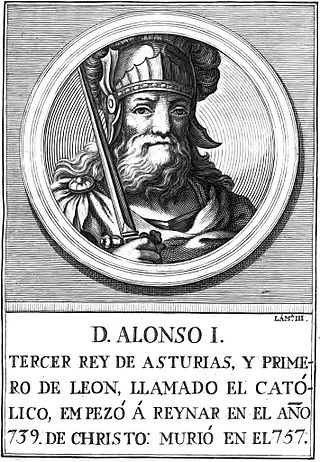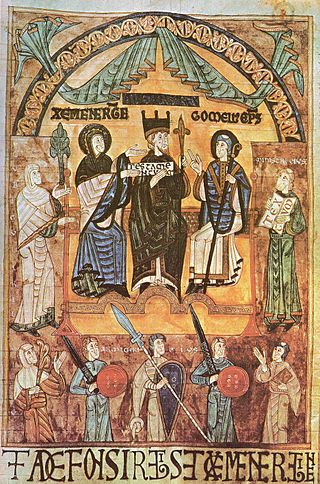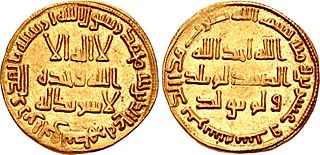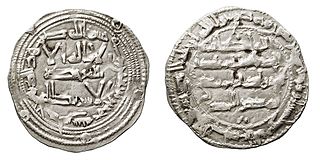
Alfonso II of Asturias, nicknamed the Chaste, was the king of Asturias during two different periods: first in the year 783 and later from 791 until his death in 842. Upon his death, Nepotian, a family member of undetermined relation, attempted to usurp the crown in place of the future Ramiro I.

Year 740 (DCCXL) was a leap year starting on Friday of the Julian calendar, the 740th year of the Common Era (CE) and Anno Domini (AD) designations, the 740th year of the 1st millennium, the 40th year of the 8th century, and the 1st year of the 740s decade. The denomination 740 for this year has been used since the early medieval period, when the Anno Domini calendar era became the prevalent method in Europe for naming years.

Alfonso III, called the Great, was the king of León, Galicia and Asturias from 866 until his death. He was the son and successor of Ordoño I. In later sources he is the earliest to be called "Emperor of Spain." He was also titled "Prince of all Galicia".

Ramiro I was king of Asturias from 842 until his death in 850. Son of King Bermudo I, he became king following a succession struggle after his predecessor, Alfonso II, died without children. During his turbulent reign, he fended off attacks from both Vikings and Moors. Architecturally, his recreational palace Santa María del Naranco and other buildings used the ramirense style that prefigured Romanesque architecture. He was a contemporary of Abd ar-Rahman II, Umayyad Emir of Córdoba.
Hisham ibn Abd al-Malik ibn Marwan was the tenth Umayyad caliph, ruling from 724 until his death in 743.

Al-Walid ibn Yazid ibn Abd al-Malik, commonly known as al-Walid II, was the eleventh Umayyad caliph, ruling from 743 until his assassination in 744. He succeeded his uncle, Hisham ibn Abd al-Malik.

Hisham IAl-Reda ibn Abd ar-Rahman was the second Emir of Cordoba, ruling from 788 to 796 in al-Andalus.
This is a timeline of notable events during the period of Muslim presence in Iberia, starting with the Umayyad conquest in the 8th century.
This is a historical timeline of Portugal.

The Battle of Mu'tah took place in September 629, between the forces of Muhammad and the army of the Byzantine Empire and their Ghassanid vassals. It took place in the village of Mu'tah in Palaestina Salutaris at the east of the Jordan River and modern-day Karak.
Ruderick, better known by his Spanish name Rodrigo, was an influential noble of the Kingdom of Asturias, and was probably the first Count of Castile (850/862–873) and Álava (867/868–870). He was an active participant in the Reconquista and a faithful vassal of Ordoño I and Alfonso the Great, kings of Asturias. By conquering land from the Moors, Rodrigo began the southern expansion of the County of Castile.
The Berber Revolt or the Kharijite Revolt of 740–743 AD took place during the reign of the Umayyad Caliph Hisham ibn Abd al-Malik and marked the first successful secession from the Arab caliphate. Fired up by Kharijite puritan preachers, the Berber revolt against their Umayyad Arab rulers began in Tangiers in 740, and was led initially by Maysara al-Matghari. The revolt soon spread through the rest of the Maghreb and across the straits to al-Andalus.
Anbasa ibn Suḥaym al-Kalbi was the Muslim wali (governor) of al-Andalus, from 721 to 726. Anbasa belonged to the tribe of Banu Kalb, which was established in southern Syria and northern Arabia since pre-Islamic times.
Sulaymān ibn Hishām ibn ʿAbd al-Malik was an Arab general, the son of the Umayyad Caliph Hisham ibn Abd al-Malik. He is known for his participation in the expeditions against the Byzantine Empire as well as his prominent role in the civil wars that occurred during the last years of the Umayyad Caliphate. Defeated by Marwan II, he fled to India, where he died.

The Battle of Pancorbo took place in 816 between a Moorish army from the Emirate of Cordoba sent by Al-Hakam I and under the control of Abd al-Karim ibn Abd al-Wahid ibn Mugit and pro-Frankish forces under the control of Balask al-Yalasqi. The battle was fought when the Córdoban forces attempted to cross the pass at Pancorbo.

The Battle of Las Babias occurred in the year 795 when the Emir of Cordoba, Hisham I of Córdoba sought to avenge his previous military incursions in 794 against the Kingdom of Asturias under the command of the brothers Abd al-Karim ibn Abd al-Walid ibn Mugaith and Abd al-Malik ibn Abd al-Walid ibn Mugaith. The previous battles resulted in devastating losses for the Emirate, most importantly at the Battle of Lutos where one of the Emir's generals was killed in action. The battle resulted in a Córdoban victory.

Toledo is the repository of more than 2000 years of history. Successively a Roman municipium, the capital of the Visigothic Kingdom, a major city in Al-Andalus and the Kingdom of Castile. Its many works of art and architecture are the product of three major religions – Judaism, Christianity and Islam.
Sa'id ibn Abd al-Malik ibn Marwan, also known as Saʿīd al-Khayr, was an Umayyad prince and governor.
Maslama ibn Hisham ibn Abd al-Malik, also known by his kunyaAbu Shakir, was an Umayyad prince and commander.











